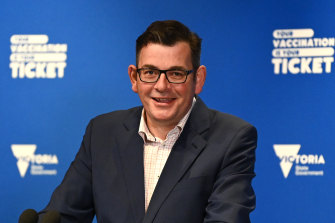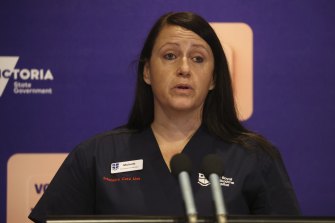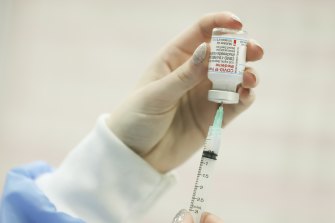For our free coronavirus pandemic coverage, learn more here.
The easing of Melbourne’s lockdown, ahead of schedule, announced by the Premier on the weekend, was accompanied by an audible sigh of relief from most.
But from health workers there was a sigh of resignation because they expect to have to deal with a surge in the number of people going to hospital – when there is the equivalent of one of Melbourne’s major hospitals full of people with COVID-19 already – and the number of people dying with COVID.
Victorian Premier Dan Andrews announcing the end of lockdown.Credit:Penny Stephens
Melburnians are rightly proud of their stamina in enduring yet another lengthy lockdown, necessary to reduce demand on the health system caused by the spread of the Delta variant from NSW back in early August. It has been hard, and the partial return of Melbourne’s cafe and pub culture is welcomed by business and consumers alike.
So, too, we welcome the increased number of people we can have at home, not to mention the opportunity to have our first proper haircut in months.
We were all getting tired of lockdown 6, and disappointingly, many were breaching some lockdown restrictions, for example, causing the post-grand final spike.
The government’s social licence for maintaining restrictions for much longer was waning, both because of the length of time we have been in lockdown and because of the risky strategies being pursued by the NSW government.
Increased out-of-home contact reduces the harm caused by social isolation, including mental illness, alcohol and drug abuse, and domestic violence. But increased social contact also increases the chance of the virus spreading, despite our rising vaccination rates.
The vaccination target Australia has adopted is idiosyncratic: the rate in the population aged 16 and older, an age limit which is neither the population eligible to be vaccinated, nor an age respected by the coronavirus which can spread to toddlers and children.
The 70 per cent rate Victoria is expected to achieve on Wednesday equates to about 56 per cent of the whole population. The 80 per cent rate we are on target to hit in early November is just two-thirds of the whole population. Both rates are well under that required to slow the spread of the virus.
Hence the sigh from stressed health workers who know that the virus will spread among the unvaccinated – children, those who can’t be vaccinated for health reasons or because of the poor logistics of the rollout which stopped First Nations Australians and people with disabilities being vaccinated, and those who refuse to be vaccinated.
Nurse Michelle Spence is one of the healthcare workers who have described the challenges of treating patients with COVID-19 in ICU wards.Credit:Paul Jeffers
Health workers have been on high alert for more than 18 months, with only brief respite between waves of COVID cases. They see yet more pressure coming, as the burden of responding to the pandemic shifts from falling on the whole population through lockdowns, to falling on the health system and its staff.
Ninety per cent of people in hospital today with COVID are unvaccinated, even though the unvaccinated now represent only one-quarter of the population. Almost everybody with COVID in an intensive care unit bed (96 per cent) is unvaccinated.
Living with COVID means a shift in the metric to be watched. Even fully vaccinated people can be infected – although it is less likely – but the major difference between the vaccinated and the unvaccinated is their risk of hospitalisation and death. For the fully vaccinated, the risk of hospitalisation and death is generally very low indeed. This is what the vaccine is designed to achieve, and it is very effective in doing so.
As the proportion of the population vaccinated increases, the measure to watch becomes hospitalisations and deaths, rather than the number of new cases. The government should begin to shift to emphasising the reporting of hospitalisations and death, because case numbers become less meaningful the more that are vaccinated.
As the proportion of the population vaccinated increases, the measure to watch becomes hospitalisations and deaths, rather than the number of new cases.Credit:Alex Ellinghausen
Each death is a tragedy and a life foreshortened. The government cannot dismiss these deaths as collateral damage and must still protect all of us from being infected.
The Victorian health system was stretched before COVID, and it is more at risk of being overwhelmed now. It will remain under intense pressure until vaccination rates are much higher than they are now, and we have worked through the current wave of infections in the unvaccinated.
With lockdown easing we will enjoy increased social contact. But with increased social contact will come increased spread of COVID and increased pressure on the health system. The government hope is that the tremendous uptake in vaccinations seen in recent weeks will continue, and the increase in vaccinations will outpace the increased spread of the virus.
The changes the Premier has announced this week are welcome. But they come with a risk.
Melburnians still have to be careful, we still need to wear masks, and those not vaccinated – who are most at risk – need to be even more careful and, if they can, get vaccinated.
Stephen Duckett, director of the Health and Aged Care Program at Grattan Institute, is double vaccinated and has inordinately long hair.
Most Viewed in National
From our partners
Source: Read Full Article





